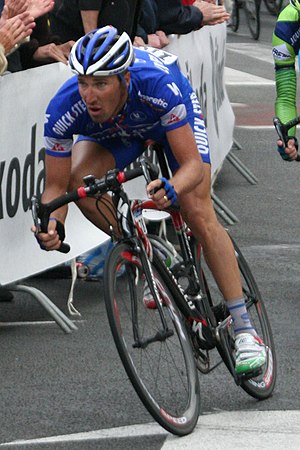運動生理学

運動生理学(うんどうせいりがく)は、 身体運動の生理学のことである。 関連する健康専門職の 1つであり、運動に対する急性的および慢性的な応答の研究領域に関わっている。
運動の効果を理解することは、 持久力トレーニングあるいは筋力トレーニングによって機能的な能力や筋力の変化を引き起こす、 筋肉 、 心血管 、および神経ホルモン系の特定の変化についての研究と関わっている [2]。 身体におけるトレーニングの効果は、運動によって身体に生じる適応応答としての反応[3]あるいは「運動によって引き起こされる代謝の向上」 [4]と定義されてきた。
運動生理学者は病気が運動に及ぼす影響や、運動によって病気の進行を遅らせたり病気から回復させるメカニズムについて研究している。
歴史[編集]
イギリスの生理学者Archibald Hillは、1922年に最大酸素摂取量と酸素負債の概念を導入した。 [5] [6] Hillおよびドイツの医師であるオットーマイヤーホフは、筋エネルギー代謝に関連する独立した研究に対して1922年のノーベル生理学または医学賞を受賞した。 [7] この業績により、科学者たちは運動中の酸素消費量の計測を始めた。 Minnesota大学のHenry Taylor、スカンジナビアの科学者であるPer-Olof ÅstrandおよびBengt Saltinが1950年代および1960年代に、とりわけHarvard Fatigue Laboratory、ドイツの大学、Copenhagen Muscle Research Centreで大きな貢献をした [8] [9]
いくつかの国では、運動生理学者はプライマリヘルスケアプロバイダーである。認定運動生理学者(AEP: Accredited Exercise Physiologists)は大学で教育を受けた専門職であり、個々人に対してさまざまな症状への治療的介入による運動処方を行う。運動処方は容量反応関係(運動量に応じた反応の関係)に基づいて行われる。
エネルギー消費[編集]
ヒトは長時いる。 [10]
代謝の変化[編集]
この節には内容がありません。(2020年9月) |
代謝は変化する
脳[編集]
この節には内容がありません。(2020年9月) |
疲労[編集]
この節には内容がありません。(2020年9月) |
心バイオマーカー[編集]
この節には内容がありません。(2020年9月) |
ヒトの適応[編集]
この節には内容がありません。(2020年9月) |
げっ歯類を用いた選択的繁殖実験[編集]
この節には内容がありません。(2020年9月) |
運動による筋肉痛[編集]
この節には内容がありません。(2020年9月) |
運動生理学の教育[編集]
この節には内容がありません。(2020年9月) |
脚注[編集]
- ^ Capostagno, B; Lambert, M. I; Lamberts, R. P (2016). “A Systematic Review of Submaximal Cycle Tests to Predict, Monitor, and Optimize Cycling Performance”. International Journal of Sports Physiology and Performance 11 (6): 707–714. doi:10.1123/ijspp.2016-0174. PMID 27701968.
- ^ Awtry, Eric H.; Balady, Gary J. (2007). “Exercise and Physical Activity”. In Topol, Eric J.. Textbook of Cardiovascular Medicine (3rd ed.). Lippincott Williams & Wilkin. p. 83. ISBN 978-0-7817-7012-5
- ^ Bompa, Tudor O.; Haff, G. Gregory (2009) [1983]. “Basis for Training”. Periodization: Theory and Methodology of Training (5th ed.). Champaign, Illinois: Human Kinetics. pp. 12–13. ISBN 9780736085472
- ^ Lee, Buddy (2010). Jump Rope Training (2nd ed.). Human Kinetics. p. 207. ISBN 978-0-7360-8978-4
- ^ Hale, Tudor (2008-02-15). “History of developments in sport and exercise physiology: A. V. Hill, maximal oxygen uptake, and oxygen debt” (英語). Journal of Sports Sciences 26 (4): 365–400. doi:10.1080/02640410701701016. ISSN 0264-0414. PMID 18228167.
- ^ Bassett, D. R.; Howley, E. T. (1997). “Maximal oxygen uptake: "classical" versus "contemporary" viewpoints”. Medicine & Science in Sports & Exercise 29 (5): 591–603. doi:10.1097/00005768-199705000-00002. ISSN 0195-9131. PMID 9140894.
- ^ “The Nobel Prize in Physiology or Medicine 1922” (英語). NobelPrize.org. 2018年10月11日閲覧。
- ^ Seiler, Stephen (2011). “A Brief History of Endurance Testing in Athletes”. SportScience 15 (5).
- ^ “History of Exercise Physiology”. Human Kinetics Europe. 2018年10月11日閲覧。
- ^ Keytel, L.R. (March 2005). “Prediction of energy expenditure from heart rate monitoring during submaximal exercise”. Journal of Sports Sciences 23 (3): 289–97. doi:10.1080/02640410470001730089. PMID 15966347 2015年4月16日閲覧。.


 French
French Deutsch
Deutsch